Intro
A couple weeks ago I raced the Trans BC — a six-day Enduro stage race in the interior of British Columbia. I wrote a quick bike check before the race, but now that the race is done and I have the benefit of hindsight, I’ve put together some thoughts on what parts of my setup worked and what didn’t.
And since I get a number of questions from Blister readers about what I personally ride and what my thought process might be when picking a bike, I go into some of that here, too.
Finally, I’ll also go over some of the trends I saw at the race when it came to other riders’ setups.
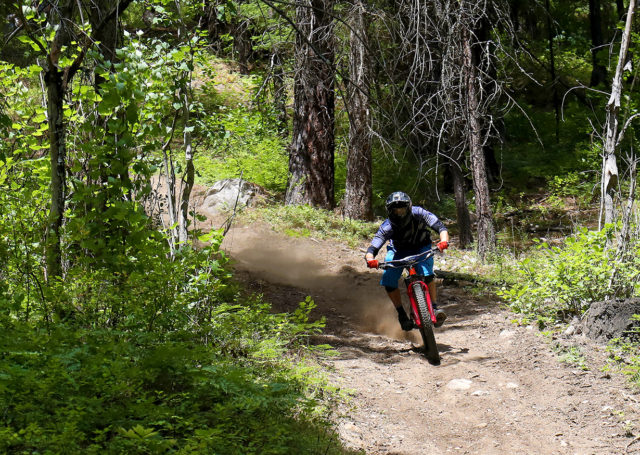
Selecting the Bike: My Criteria
Figuring out the bike for the race was, for a gear nerd such as myself, a pretty fun exercise. I went into this basing my decisions on a few pieces of information:
(1) The race took place mostly in Rossland and Nelson, where everything is steep, and everything is technical. A “blue” trail in Nelson would be a double black in a lot of other places. And a double black in Nelson means that it’s probably either the steepest trail you’ve ever ridden, or it has massive features on it. Or, more often, both. So I wanted a bike that’s comfortable on really steep stuff, and really rough stuff. And I wanted good brakes.
(2) The climbs in that area tend to be on logging roads, and they tend to be brutally steep. And since the Trans BC is an Enduro race (so the climbs aren’t timed) I wasn’t going to be in any hurry on the way up, so I wanted an easy climbing gear.
(3) We put in a lot of mileage and a lot vert, every day, for a week. We ended up doing around 31,000 feet of climbing and about 45,000 feet of descending over the course of roughly 145 miles. So part of the race was going fast on the timed stages. But part of it was just preserving my body so I’m still functional on day six. As a result, I wanted a bike that’s at least semi-efficient.
(4) I wanted a bike that could hold a water bottle. For short stages with aid stations, I didn’t want to have to carry a pack for water.
(5) It’s blind racing — while I’ve ridden around Nelson and Rossland a lot, I knew that most of the stages would be on trails I’d never ridden before, or at most had ridden once or twice quite some time ago. Although some of the stages are on popular trails in the area, the race makes a point of getting onto some lesser known (and sometimes brand-new) trails that even locals were unlikely to have ridden before. This, among other things, meant that I could expect to make a lot of mistakes, I knew I’d pick bad lines, and I knew that I was going to run into things that are not conducive to maintaining forward momentum. So I wanted 29” wheels, because they’re good at smoothing out mistakes.
So, with all that in mind, I narrowed down my list of bikes that I wanted to ride for the race. And I haven’t actually ridden many of these bikes — like most people, I’m making decisions here based on speculation and moderate amounts of guessing.
Bike Contenders
Great bike, and super fast on pedally courses. But at least for me, it feels undergunned when things get legitimately steep and rough.
Santa Cruz Hightower LT
I haven’t ridden the LT (aka, “long travel”) version of the Hightower, but I’ve ridden the regular Hightower a lot. It’s a great climber and super efficient pedaler, but a bit less supple in the rough stuff. I wanted something that prioritized supple suspension a bit more.
Specialized Enduro 29
They’re nice bikes, and they’re light. But if I’m nitpicking, I don’t like Specialized Enduros’ suspension action as much as the best options, I think the frames feel a bit flexy, and I find Specialized’s wheels to be too light. But I’m confident that this would have been a solid option.
The Ripmo would have been high on my list, but it hadn’t been released when I was making this decision.
Commencal Meta AM 29
Same story as the Ripmo — probably would have been a contender, but wasn’t available when I was making the call.
Rocky Mountain Instinct BC
I wasn’t a huge fan of the prior iteration of the Instinct, but the new one looks like a whole different beast, and I’ve heard good things about it. That said, my prior experiences left me a little skeptical, and regardless, the Instinct BC was pretty tough to come by earlier this spring.
Evil Wreckoning
I think I would’ve been pretty happy on this one. I haven’t spent much time on a Wreckoning, but it seems like it’s maybe not the most efficient option, and probably a touch heavy, but I don’t think either of those factors would’ve really mattered. So I’d put the Wreckoning in the category of “probably would’ve been great, and circumstances regarding availability were more determinative than any detail about the bike.”
Transition Sentinel
This one looks super interesting, and would be high on my list. I’ve been a fan of the other Transitions I’ve ridden, so I’d put this one up there as roughly co-equal with what I ended up with. (As a side note, the guy who won the race was on a Sentinel.)
So all that pondering brought me to…
I wrote a full review of the Slash not too long ago, but long story short: great suspension action, maintains really good traction in the rough, super slack head angle keeps it stable, and it’s just efficient enough to be manageable for big days.
I also had the opportunity to take a couple quick trips up to Rossland and Nelson to ride the Slash on those trails, and that pretty much clinched the decision. The Slash is comfortable on steep stuff since it’s so slack, the suspension is smooth under heavy braking, and yeah — I was doing a lot of heavy braking, so that’s noteworthy.
In an ideal world, I wish the Slash was a smidge longer, both in reach and wheelbase, and I wish the chainstays were a little longer as well. But all things considered, I’m super psyched on the bike.
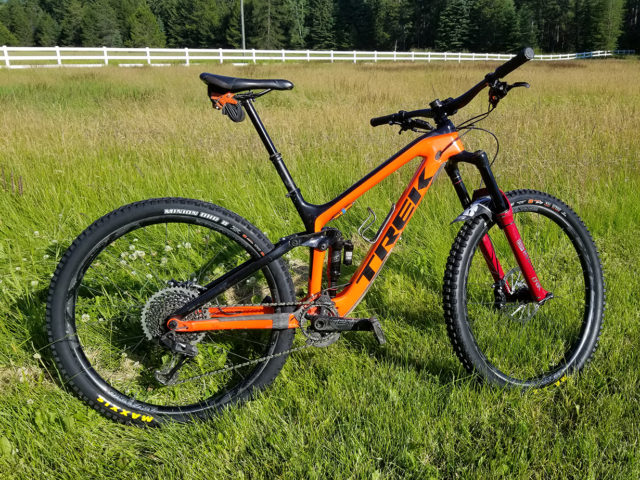
There are a couple things that, in hindsight, made the Slash work well. First and foremost, it’s slack. Trek says that in low mode, the head angle is 65.1°, which is quite slack. By my measurement, with the 160 mm RockShox Lyrik I swapped on the front and 2.5” tire in the front and a 2.3” tire in the rear, the head angle was somewhere around 64.4°. That super slack front end makes it easy to smash through stuff without fear of going over the bars.
With regard to the sizing, as I said, ideally the bike would be a little bigger. But I also think having a slightly smaller bike made the climbs more comfortable, and it helped on the trails that had tight and awkward sections (of which there were plenty). Though some extra length would’ve been nice at speed.
I also thought the build kit on the Slash 9.8 was super solid — if I was going to race a 100% stock bike, I wouldn’t be at all disappointed with the 9.8’s component selection.
But again, I’m a gear nerd, and this was a good opportunity to pimp out the bike with the exact parts that I wanted, which is something I don’t get to do all that often with review bikes.
So down the rabbit hole of parts swapping we go…
Parts Swapping
For the race, I changed almost every part on the bike, so we’ll start with the parts I didn’t change from the stock Slash 9.8 build:
MRP AMg Chainguide: Yup, given every option out there, this is still probably what I’d pick. I see no reason to change it.
SRAM GX Eagle Rear Derailleur: On steep climbs, I definitely wanted that 50-tooth easy gear. But on rough descents, any rear derailleur is pretty likely to take a beating and I consider it to be a semi-disposable part. The GX Eagle hits the inflection point of functionality while being cheap enough that I’m not super pissed when I destroy it.
SRAM GX Eagle Chain: It works well. It shifts well. And I don’t care that much about the hollow pins on the more expensive X01 chain. I did, however, put a fresh GX Eagle chain on for the race.
SRAM Clean Sweep Disc Rotors: 200 mm in the front, 180 mm in the back. I could have gone to a 200 mm rotor in the rear, but I tend to ride way over the front of the bike, so rear braking power is a little less important to me. The 180 mm worked fine.
And now for the parts that I swapped out. These basically fall into two categories: (1) components that I swapped to improve performance, and (2) components that I swapped to save weight. We’ll start with the performance-oriented changes:
Parts Swapped to Improve Performance
RockShox Lyrik RC2 Fork: As I mentioned in the Slash review, the Fox 36 Performance fork that came stock on the Slash 9.8 just never quite matched the suppleness of the Slash’s rear end. The Lyrik, on the other hand, has some of the most impressive small-bump sensitivity of any single-crown fork I’ve ridden, all while being supportive when it needs to be, not blowing through its travel, and having a pleasantly stiff chassis. And it’s red, which is obviously the fastest color.
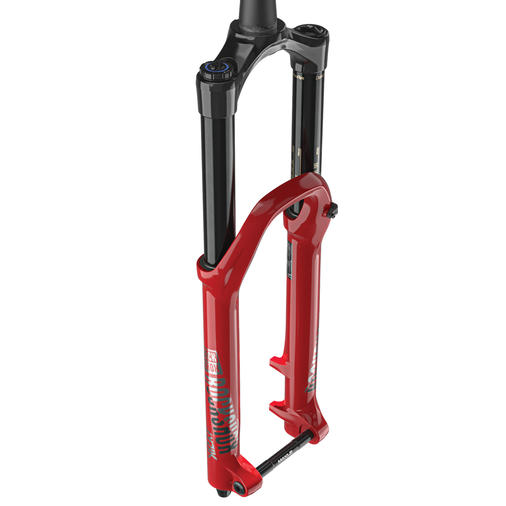
I debated bumping up to 170 mm travel, but I was worried about making the front end of the Slash too slack. I also debated going down to a 42 mm offset, but I wasn’t entirely sure how that’d ride, and I knew that I got along alright with the 51 mm offset, so I ended up going with what I knew.
RockShox Super Deluxe Rear Shock: I actually prefer the Slash 9.8’s stock RockShox Deluxe Thru Shaft shock, but that stock shock died. It needed a rebuild that I didn’t have time for before the race, and then one of the trunnion mount bolts rattled loose on a long descent on the first day of the race, and I didn’t notice it until it’d bungled the threads on the shock. So I did most of the race on the Super Deluxe, which is still a great shock but doesn’t have the planted, ultra-tractiony feeling of the Thru Shaft.
RaceFace Next R Wheels: My criteria for a wheelset was (1) stiff, (2) a rim with a ~30 mm internal width, (3) a rear hub with good engagement, and (4) reasonably light while still being durable. The Next R’s checked all of these boxes — they’re noticeably stiffer than the Slash 9.8’s stock Bontrager wheels, the 31 mm rim width works well with anything from a 2.3” to 2.6” tire, the Vault hubs have great engagement, and at around 1750 grams, they’re light enough to not feel heavy, but heavy enough to not feel fragile.
Sram Code RSC Brakes: Up until about two weeks before the race, I was convinced that the Guide RS brakes that came stock on the Slash 9.8 were fine. And then I took a weekend trip to Nelson, rode “The Gimp” (it’s steep), and promptly decided that I wanted better brakes. The Code RSC’s are the best DH stoppers I’ve ridden, so I stole those off of my DH bike. I said it in the review, and I’ll say it again — it’s just sooo easy to get the Code RSC’s set up exactly how I want them.

Tires: This is probably the area where I spent the most time second-guessing myself. There are plenty of tires that I like, and for day-to-day riding that isn’t a race, there are probably even some tires that I like better than the ones I ended up choosing. But my priorities for the race were (1) no flat tires, (2) lots of braking traction, and (3) as much grip as I can get, while also still being manageable for 5,000 feet of climbing, six days in a row.
So I ended up with a Maxxis DHF 2.5” 3C MaxxGrip, DH casing in the front, and a Maxxis DHR2 2.3” 3C MaxxTerra, DoubleDown casing in the rear. Yes, it’s slightly odd to have a heavier casing in the front, but I wanted the MaxxGrip rubber compound in the front, and for 29” wheels, Maxxis only offers that in a DH casing. I experimented with a 2.4” DHR2 MaxxGrip in the rear, but it just felt too heavy and slow on the climbs, so I went with the narrower (2.3”) and faster-rolling (MaxxTerra) DHR2 instead. For that size and rubber compound, the DoubleDown casing is the burliest option.
RaceFace Turbine R Seatpost: The Slash 9.8’s stock Bontrager post only had a 125 mm drop, which wasn’t going to cut it. I went with a 150 mm drop on the Turbine R because that’s the longest post I could fit in the Slash. And I went with the Turbine R just because it’s fairly reliable, the cable is easy to replace, and I like the shape of their 1x lever.
Catahoula Ergonomics Saddle: In my initial bike check, I said I was sticking with the stock Bontrager seat. And while I do get along just fine with the Bontrager seat, for long, hot days in the saddle, the Catahoula leaves my nether regions feeling much happier. Case in point: six long days in the saddle, and my ass was still fine to keep riding the days after the race.
Parts Swapped to Save Weight
The other parts I swapped out had more to do with weight savings. And really, I gained a bunch of weight by swapping to burlier tires, so as much as anything, I was trying to offset those weight gains.
Race Face Next R Cranks: I’ve been a fan of all of Race Face’s carbon cranks, and these are no different. They’re light, and despite smashing them off of all kinds of rocks, they’re still running smoothly.
Race Face Turbine Stem and Next R Handlebar: Nothing too crazy here; I just wanted to bump down to a 40 mm stem, and I like the shape of the Race Face bars. I also find the Race Face bars to have a good mix of stiffness and damping qualities that keep my hands and forearms a little happier on long descents.
Between the cranks, stem, and handlebars, I probably saved around 200 grams over the stock build, which at least partially offset the weight I gained from the other parts swaps. Of course, a lot of the weight I gained was from the tires, and that’s rotating weight, but there’s not much I can do about that.
Other Bits and Pieces
I had a fender on the front — a Marsh Guard sort of thing, which works great. I put them on pretty much every bike I review.
I had Fix It Sticks mounted to the bike, which provide quick access to a 4, 5, 6 mm, and T25 wrench. Great for quickly fixing whatever little thing is out of whack at any given moment.
I used a King titanium bottle cage. I’ve had that thing for a decade or so — never lost a bottle with it, it weighs essentially nothing, and it looks classy.
Lastly, I had a tube strapped under my saddle with a Voile ski strap. It’s simple and it works.
What Worked & What Didn’t
All in all, there’s not too much I would do differently.
First, the high points: the Lyrik is a ridiculously good fork. I’m impressed with that thing, and it gets a bunch of credit not only for keeping the front tire tracking where I wanted it to, but also for keeping my hands and forearms functional on a lot of the long descents.
I also have to give a nod to the GX Eagle drivetrain — I spent a lot of time trying to conserve energy, creeping uphill in that 50-tooth cog.
The Code RSC brakes were also a huge benefit on some of the sustained descents. There was one particularly long, particularly steep stage where I ended up using two fingers on my brakes for the first time in at least a decade. I can’t really overstate how steep and sustained that descent was, but all I could think of was “I’m soooo glad I’m not on lesser brakes.” That stage was pure carnage, and I think a lot of people on more Trail-oriented brakes completely cooked their fluid and rotors.
Honorable mentions go to the Next R wheels and seatpost. I really just want my wheels and seatpost to work without issue, and that’s exactly what they did. The wheels in particular get some credit here — the stickers and graphics are completely shredded from rock strikes and getting smashed through unwelcoming trail debris, but they’re still rolling straight and true without issue.
So what didn’t work so well?
I had two noteworthy mechanicals, one of which I think was my fault, and one was just bad luck.
The first was a broken chain, which I think was a result of a particularly ham-handed shift in the previous stage. I slammed through the gears for a finish-line sprint, and I think I slightly bent a link. On the transfer between stages, my shifting was a little funny, but I fussed with the barrel adjuster and didn’t think much of it. On the next stage, my chain broke. In hindsight, I should’ve inspected the chain more closely before dropping into the stage — I had a quick link with me, and it would’ve been a quick fix to remove a bent link.
The second mechanical was just bad luck — we were racing a freshly cut trail that was still pretty rough in spots. It was a steep stage with one short bit of pedaling. I was throwing as much torque at the pedals as my chicken legs could muster when a stick hopped up into my drivetrain. Before I knew what had happened, the derailleur had sheared off and tangled itself in the spokes.
Luckily none of the spokes broke, so I was able to punch the chain and coast down to the finish. Doubly lucky was that I had a derailleur hanger, spare derailleur, and spare chain nearby, so I was able to swap everything out and finish the day. This also confirmed my decision to stick with cheap drivetrain parts because they were probably going to get broken. Looking back on it, I’m not sure there’s much I could have done to avoid it aside from being luckier.
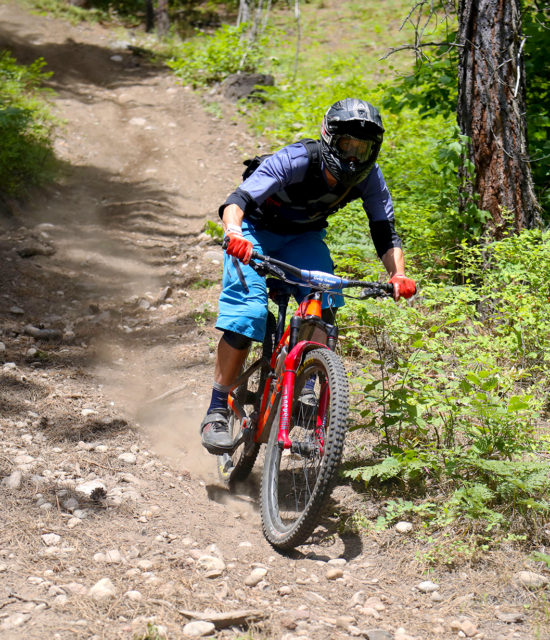
All in all, those two events weren’t too terrible in the grand scheme of things. I lost enough time on those two mechanicals to kill any chance I had of finishing in the top 10, but that’s racing, and I’m sure there were other racers who had similar setbacks. And as far as mechanicals go, the ones I dealt with were both pretty easily repairable, and neither of them caused me to crash.
But speaking of crashing, I did plenty of that, all of which were my fault. But that brings up the one other thing I’d do differently. I found that, even on relatively minor crashes, the Slash’s bars were twisting quite frequently, and I think this was because of the Knock Block system on the Slash.
Since I was using a Race Face stem, I needed to use an adaptor to allow the use of a non-Knock-Block stem (the adaptor is basically just a headset spacer with a pinch bolt). The problem here is that, even in small crashes, the headset hits the Knock Block bumper, but the stem’s pinch bolts aren’t strong enough to keep the bar from twisting. So in several stupid little crashes that would normally be non-issues, I lost a bit of time having to straighten out my bars. If I were to do it all over again, I’d probably just use a Bontrager stem that keys into the Knock Block system and thus can’t twist.
So let’s talk about tires. If I were to do it all over again, I think I’d stick with the combo I settled on. I didn’t get any flats, so at least for the rear tire, the DoubleDown casing was fine. And I still think a bigger, grippier rear tire would’ve hurt a lot on the climbs (although it would have been great on some of the descents).
I was running tubeless with a normal amount (2-ish ounces, very imprecisely measured) of Orange Seal in the tires. I ran 19 psi in the front, and 25 psi in the rear throughout the race, and that seemed to be a good sweet spot. With a heavier casing and / or wider rear tire, I could have gone 1-2 psi lower in the rear, and that would’ve helped on some stages. But like I said, looking back on it, I don’t think I would’ve done anything differently.
Some guys were running a Maxxis Aggressor in the rear, which looked good for the transfers and the more pedal-y stages, but they weren’t too psyched on them in the wet and on the steeps. I saw one guy on a semi-slick tire, which seemed terrifying. Based on the noise he made when he rolled into one of the steepest chutes of the race, I think he agreed.
Most of the fastest guys were using 2.5 DHF / 2.4 DHR2 in a MaxxGrip / DH casing for both, but I’m just not sure I had the fitness and strength to make those work. As it was, it seemed like I tended to be slower on the more pedal-y stages, so I didn’t need that extra rubber working against me.
Other Off-The-Bike Mentionables
Most of what I’ve written is about the bike I was riding, but there are a few other pieces of my kit that I’ve been pretty happy with and are worth noting.
I used the Henty Enduro Backpack for the whole race. Most of the race was pretty hot, so I was going through a lot of water and the extra capacity of the Henty was pretty crucial. On most days, I was carrying 2.5 liters in the pack and another 16 ounces in a water bottle. Plus a bunch of food, tools, and on the climbs, a full-face helmet.
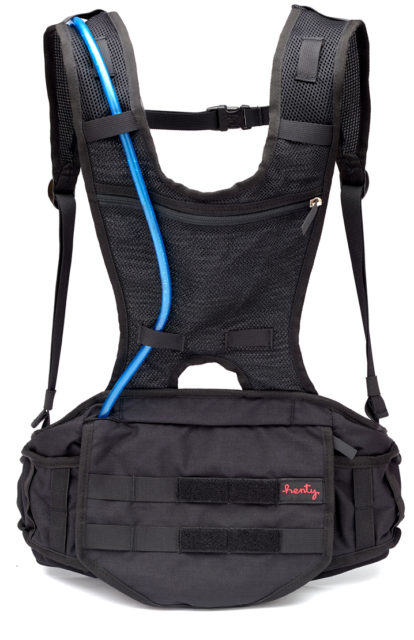
The only noteworthy tool in the pack was a Dynaplug racer kit for plugging holes in tires. I didn’t need it during the race, but I’ve used it on a few other rides and have been happy with it. It’s a super slick system, and it barely takes up any room in the pack.
For my helmet, I mostly used the full-face Leatt DBX 6.0. The race organizers were ok with people riding helmetless on the climbs, so there really wasn’t any reason to not wear the full face (and the terrain certainly warranted it).
For shoes, I was wearing 5.10 Hellcat Pros. They’re hot, and they smell terrible now, but they protected my feet when I smashed them into quite a few roots and rocks, and when I ended up riding down a bunch of sketchy trail unclipped, they stuck to my pedals about as well as any clipless shoe I’ve ridden.
We spent the week of the race — and sometime after the race — living out of our truck-bed camper, and we were using a Kuat NV 2.0 rack mounted to the Kuat Pivot I reviewed earlier this spring. The rack is great, but the Pivot is the real winner — that thing is fantastic for the “on the back of a camper” scenario.
General Notes & Observations on Other Setups
As a gear nerd, it’s always interesting to go to these races and see who’s on what, and what seems to be working well. Particularly at a race like this, because it’s a great test of equipment on some rowdy trails, but most of the racers aren’t professionals and they’re not sponsored. While the top guys are getting hookups, the vast majority of the field is comprised of people that are probably at the upper end of their local riding scene, but aren’t racing for anyone, or with any particular goal in mind.
And of course, this also comes with the caveat that this is an expensive race, and to a lot of people, it’s more about the experience rather than finishing first, and thus tends to attract a certain strain of mountain biker. Not to mention, it’s a week-long event and there are plenty of people who just can’t swing a week off from work for a race.
To put it another way, the parking lot looked like a Sprinter convention.
So with that in mind, looking around, I noticed some trends. For starters, I saw more 29ers than 27.5’s, I’m guessing for mostly the same reasons that I settled on a 29er. And I’m not sure I saw anyone on 26” wheels. Transition Sentinels were well represented, as were Yeti 5.5’s, Evil Wreckonings, and Santa Cruz Hightower LT’s. Of the major brands, Giant and Kona were the ones that I found to be noticeably absent — I think I only saw 3 or 4 people on Giants at the race, and about the same number on Konas.
There was one guy on a hardtail. I have no idea how he ended up placing, but he gets significant credit just for surviving some of those stages.
I don’t think I saw a single person on a Plus bike. There were definitely some 2.6” tires in the mix, but those were very much the exception. 2.3” to 2.5” seemed to be the tire sweet spot.
Lots of people had upgraded to coil shocks. Fox DHX2’s seemed to be the most common upgrade, but there were plenty of more exotic options. There were quite a few Push Elevensixes.
Carbon wheels were certainly common, but not as ubiquitous as you might expect at a race like this.
Conclusion
I’ve expended enough words on my setup that it’s probably apparent by now that this was something I’d spent a lot of time thinking about. It took a fair amount of work to prep physically for a race like this, but I also spent far too much time thinking about gear choices and getting the bike ready. Because, let’s face it — it’s an expensive and difficult race, and it’d suck to throw it all away because of a mechanical failure.
All in all, I’m pretty pleased with how things went. I ended up in 20th overall, which was a bit better than I was hoping for, and I had a good time doing it. We rode some rad trails, punished our bodies, fell over a bit, and got humbled by the guys that were going legitimately fast. I’m not sure I’m in any huge rush to do it again, but it was a good test of both body and equipment, and for the most part, both got the job done better than expected.

Hey Noah…you are a heck of writer bud….appreciate all you do.
Question….what pedals do you use…for this race and local whitefish type stuff?
Thanks!
Craig
Hey Craig,
Thanks!
I’m running Time MX6’s on everything except the DH bike (which has Time Z’s) and the dirt jumper (which has whatever flat pedals are lying around, currently some ancient Azonics). In the distant past, I used assorted Shimano SPD’s, but I found that I’d unclip by accident in corners and some jumps, so I wanted more float. This was about 15 years ago, and at the time the options were essentially Time or Crank Brothers, and the Crank Brothers of that era were terrible for durability. So I switched to Times and have stuck with them ever since.
-Noah
Thanks Noah!
Appreciate it….I will look into those!
Craig
Awesome write up mate, loving the detail!
Fun article, thanks!
Damn, being a mostly rugged xc kind of guy — and a bit older — this event is well beyond me. Mad props to you for mixing it up with the Canucks! Glad the Slash treated you well.
Loved this: “To put it another way, the parking lot looked like a Sprinter convention.” FWIW, this is the best article I’ve ever seen on how to get a killer deal on a lightly used, low mileage, full sized van. Moto oriented, but applies nevertheless: http://www.motorcycle.com/features/great-moto-hauler-wont-break-bank-part-1.html